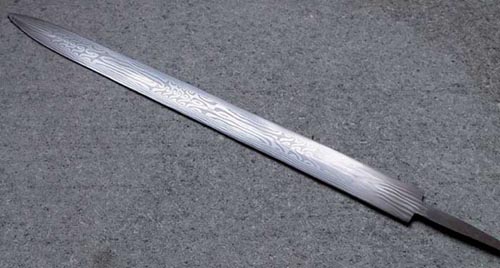Captain Larraq
Capitalist

Image Source: Wootz Steel, real world
OOC Credit: [member="Ijaat Akun"] for his RL knowledge of metalworking and initial draft of the submission's description
Intent: To create a unique metal for use by Mandalorians that reflects their cultural affinity with metalworking, while also creating a more common alternative to Beskar among the Mandalorian people.
Development Thread: As needed
Manufacturer: Mandalorian Beskar Smiths
Model: Mandalorian Steel
Affiliation: Mandalorians,
Modularity: NA
Production: Mass Production
Material: Common Iron Ore, Carbon Nanotubes, Ciridium, Lamination, various common ores and minerals,
Description:
Mandalorian Steel, or as it is known to the Mando'ade as "Euk'gar" or "Little Iron", is a recent development from numerous Beskarsmiths throughout Mandalore, with significant contributions from smith Ijaat Akun. The increasingly difficult to acquire beskar and the number of skilled smiths facing financial difficulty do to the lack of materials to work with resulted in a number of smiths seeking to apply their skills and techniques to the working of more common metals. Elsewhere on Mandalore a number of individuals with vast corporate backing attempted to utilize molecular forges and other similar devices in a similar attempt to convert traditional metals and alloys into a beskar-like compount.
However, such attempts proved incapable of replicating the crystalline structures of native beskar ore in more common variants of iron. With the attempts proving unsuccessful, it fell to the skill of individual smiths and the ancient traditions of the Mando'ade to accomplish what technology could not.
Working with the far more common iron ores present on the planets in and around the Mandalore and Ordo systems, all abundantly profused by silicates and other properties, Mandalorian Smiths set about applying their individual techniques of Beskar construction to these more common ores.
Mandalorian Steel is characterized by a pattern or whorl of bands, which were formed of either mertensitic matrices or pearlite matrices, depending on the properties desired for the individual section of steel. For sturdy, durable plating, pearlite matrices were used which provided durability but were incapable of being used to create a sharp blade. Less durable but capable of holding a sharper blade, martensitic matrices were used for either the entirety of small blades like Beskads or were bonded to a pearlite matrixed backing for single sided blade weapons.
When needing to produce a metal using ore with a lower carbon rating, the inclusion of ferrite and pearlite banding was performed. This resulted in, spring tempered metals used primarily for armors, the tempering and inclusions enabling a thinner but denser sheet to be used in the armor with minimal, if any loss of protection and guarding.
Overall, despite the various changes to the base product via crucible smelting process, the starting ore mixture was always the same. From a basic iron ore was added lommite - a silicate type inclusion which would help the metal flex and 'bend' under distress and pressure. Particularly in blades, this inclusion would allow the blade to bend and flex and still return to true without a permanent set to the blade.

Instead of adding simple carbons to the ore during smelting iron ore into steel, a process well known for its ability to vastly strengthen the resulting metal, Mandalorian Smiths instead utilized more advanced carbon nanotubes to enhance the natural crystal matrices of the ore. Trace amounts of meleenium and ciridium were added to the ore during the smelting process to improve the density of the matrix structures in the new steel, just as it was used in the forging of Beskar. Also included in the metal alloy were flecks of neutronium and zersium. These helped allow the steel to disperse energy from blasters, thermal sources, and other energy-based threats throughout a larger overall portion of the steel.
Each section of ore, additives included, was flattened and folded in on itself over and over during the forging process. This was done in highly precise manners either via teams of strikers, hydraulic presses, or even power hammers so that the various deposits and included minerals were 'cross hatched' throughout the alloy. The final product was a metal that proved to be lighter than alusteel and phrik, but with a durability that was superior to durasteel and could be compared to Matrix Armor. In terms of blaster and lightsaber resistance, the metal proved to have properties similar to duraplast and Turadium. At basic thicknesses, such as those used in blades and personal armors, it could withstand several impacts from blaster weapons and glancing blows from lightsabers. In the case of thick plating, such as bulkhead doors and starship grade armor plating, the armor was capable of withstanding several powerful hits from blaster and laser weapons before yielding and could even withstand direct contact with a lightsaber for a time (similar to Turadium).
While the new metal has been a boon to Mandalorian Metalworkers everywhere and provides an excellent option for everything from Starship and Vehicle construction down to personal protective armors, Mandalorian Steel proves vastly inferior to Beskar, even when thickly plated to the point of matching Beskar in weight and mass.
In spite of this, Mandalorian Steel has become a popular construction material among Mandalorians and is viewed as the cultural legacy of the Beskar that still holds reverence to the Mando'ade people.
Special Features:
- Roughly comparable to Matrix Armor (overall)
- Better than Durasteel, worse than a restricted metal. (kinetic durability)
- Better than Duraplast, worse than a restricted metal. (energy/thermal resistance)
- Roughly comparable to Turadium (lightsaber resistance)
- Lighter than Alusteel (weight)

Primary Source:









